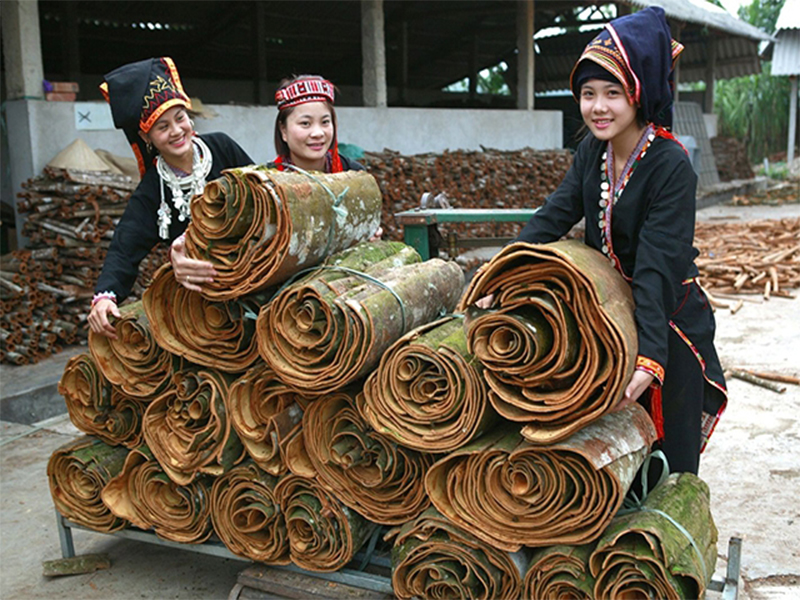Famous Cinnamon areas in Vietnam.
Realizing the high economic potential and health benefits of growing wild cinnamon, many cinnamon growing development programs and projects have been put into practice in the provinces of our country. Some famous cinnamon growing regions in the country include Que Tra Mi region, Que Yen Bai region, Que Phong cinnamon region and Que Quang Ninh region.
Planting wild cinnamon trees not only greens bare hills, it is also a source of valuable spices and medicinal herbs for human health. This is also a potential economic development direction for mountain people in general as well as ethnic minorities in particular.

Characteristics of Wild Cinnamon Tree
In our country, the scientific name of wild cinnamon tree is Cinnamomum cassia Nees et Bl. In addition, each region may have other names such as Que Yen Bai, Que Quy, Que Quang, May Que (Tay)...
Cinnamon is a tree about 10-20m tall. The bark of the tree is gray-brown. When the tree is young, the bark is thin and smooth. When the tree is old, the bark is rough and thick. Cinnamon leaves are mainly single, oblong, growing nearly symmetrically or alternately. Cinnamon flowers grow in white or yellowish clusters.
Growth characteristics.
When first planted, cinnamon trees need shade to grow and develop. The older they get, the less shade-tolerant the tree becomes. After about 3-4 years of growing cinnamon trees, they will completely love light. At that time, the tree's root system had developed firmly, with large roots penetrating deep into the soil, small roots growing wide and crisscrossing each other. Thanks to that, the tree has a sturdy base and grows healthily in areas with less fertile soil and steep hills. Wild cinnamon trees have a quite long growth cycle. It takes 8-10 years for the tree to start flowering. The flowers are only about half a grain of rice, but the scent is very fragrant and cool throughout the hills.
Harvest.
Normally, in low cinnamon forests, it only takes about 3-5 years for people to harvest. However, for high quality products, cinnamon trees are required to be over 15 years old. All parts of the cinnamon tree such as bark, leaves, flowers, wood, and roots can be used. But people mainly harvest cinnamon bark, cinnamon branches or leaves to dry or store essential oils.
Famous cinnamon areas in Vietnam.
Wild cinnamon often grows mixed in naturally humid tropical forests. Our country often plans areas next to self-growing trees into 4 main cinnamon growing areas including: Tra Mi Cinnamon area; Que Yen Bai area; Que Que Phong region and Que Quang Ninh region. Each region has its own distinct nuances.
Tra Mi - Tra Bong Cinnamon Region.
Tra Mi and Tra Bong are two regions that have long been famous for growing cinnamon in both yield and quality of wild cinnamon trees. Here, the average annual temperature is about 22 degrees Celsius, rainfall is 2,300mm/year and average humidity is 85%. Tra Mi cinnamon region, Tra Bong has an altitude of about 400-500m.
Here, cinnamon is not simply an economic resource but also a familiar tree, long associated with ethnic minorities such as Ca Toong, Ca Tu, and Bu. Communes that grow a lot of cinnamon include Tra Thuy in Tra Bong, Tra Mai in Tra Mi and some other communes such as Tra Quan, Tra Hiep, Tra Long, and Tra Giac.
Que Yen Bai region.
This land has many advantages to develop the cultivation of wild cinnamon trees such as: divided mountainous areas, altitudes of 300-700m, average annual temperature of about 22.7 degrees Celsius, heavy rainfall and high humidity. In some places, the rainfall reaches 3000mm and the humidity reaches 84%.
Thanks to that, this is the cinnamon growing area with the largest growing area and output of cinnamon bark in the country. The output in four districts of Van Yen, Van Chan, Van Ban, and Tran Yen alone can account for 70% of the entire Yen Bai cinnamon growing area. In Yen Bai, typical cinnamon growing areas are Dai Son, Vien Son, Xuan Tam, Phong Du, Chau Que...
Yen Phong Thuong Xuan area.
The average altitude here is about 300-700m, located between the Chu and Hien river basins, so there is abundant water source. The average annual temperature is 23.1 degrees Celsius; Rainfall is over 2000mm/year with an average humidity of 85%. Because of such natural conditions, wild cinnamon trees here grow very well.
Some prominent cinnamon growing areas here include Que Phong and Quy Chau districts of Nghe An province and Thuong Xuan and Ngoc Lac districts of Thanh Hoa province. Cinnamon here has a high essential oil content and is carefully exploited and processed by Muong, Man, and Thai ethnic people, so the product has a reputation and high economic value.
Que Quang Ninh region.
Wild cinnamon trees are grown on 200-400m high belts. The average temperature is 23 degrees Celsius and rainfall reaches 2,300mm/year, helping cinnamon trees grow healthily here. Cinnamon gardens here are not only a source of domestic products but also serve foreign exports. There are typical cinnamon growing areas such as Ha Coi, Hai Ninh, Dam Hoa, Tien Yeu and Binh Lieu.
Thanks to the planting of wild cinnamon trees, the lives of the people who used to have to work hard in the past, but now have to worry about tomorrow's food, have gradually become better, the quality of life has improved in all aspects, and people no longer worried about poverty but also assured of economic development.


